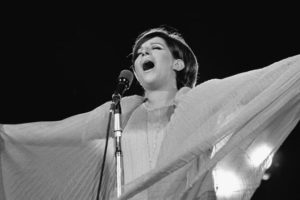
A 1989 production of Verdi’s Un ballo in maschera should have been another jewel in Herbert von Karajan’s already quite impressive crown. A stellar cast, an impeccable orchestra, an enormous period set –the grand opera of Salzburg under his regime. He had recently finished a studio recording with the cast, and was preparing them for the opening night.
Unfortunately, Karajan died shortly before the premiere, and as a last minute replacement, Georg Solti was flown in. This DVD records a revival from the following year with the same cast, and any hiccups that may have occurred at the debut have been eradicated completely.
Solti has an iron grip on the Vienna Philharmonic. His movements are sharp and precise, emphasizing the sudden punches in Verdi’s score. The approach is structural, allowing the drama to build up gradually throughout the evening, until it becomes clear that Verdi is hurtling towards disaster. Most impressively, the many ensembles numbers are air-tight, and every voice can be clearly heard.
The production is traditional in all the best ways. The liner notes describe Karajan’s choice to return the setting to Sweden as “unusual,” which although not particularly true, certainly adds local flavor. At any rate, opulence is the theme of the day, and the Count of Anckarström’s wood-lined apartment is almost comically oversized.
But overall, William Dudley’s sets are impressive, particularly in the last act, where the masked ball is epic. John Schlesinger’s direction is clear and detailed even with his enormous cast. The major characters are clearly thought out, and the chorus resorts to fewer ‘”historical” stock gestures than usual. The video is well produced, with Brian Large’s camerawork catching fascinating details as well as emphasizing the grandeur of the production.
Plácido Domingo is clearly the star, and he acquits himself beautifully. He may sound a bit less velvety than some of his other Gustavos over the previous two decades, but he has found new depth over that same time – he is still very much in his prime. Verdi’s characterization doesn’t match the psychological detail found in his later despots juggling political and romantic agendas (as perhaps Philippe or Amneris), but Domingo brings a profound sense of guilt that wasn’t apparent in his more youthful performances.
Josephine Barstow is not an immediately obvious Amelia; her sound is unambiguously British, as is her characterization. If not ideal vocally, she is utterly convincing as a political wife – stiff and correct in bearing, terrified of being discovered, but more ashamed at her indiscretions. The opening ‘morrò’ in her Act III aria is spit out with particular self-disgust, and she is a woman who has fallen far in her own eyes. She is too reserved to generate a lot of sympathy, and the pleasure is rather like watching the fall of one of the more self-deluded Real Housewives of reality tv. She does sing better than any of the women of that series, but many will prefer Ricciarelli or Millo on competing DVDs.
Leo Nucci makes little impression as the Count Anckarström. For the first two acts he sings decently but without much presence. Only when he and Barstow are alone in Act III does he start to feel like an important character, and we start to get a sense of his inner conflict. The Karajan studio recording finds him in better voice.
Sumi Jo makes a charming Oscar in her Swedish pageboy outfits by Luciana Arrighi – one wonders why Gustavo picks a rather cold married woman rather than the sexy (and unconvincingly male) intern. Her voice is the smallest of the cast, but we loose only the occasional recit; her high notes cut through the large ensemble numbers, her tone velvety and coloratura rapid-fire. Thankfully Solti prefers faster tempos than on the Karajan recording, and they suit her temperament perfectly.
Florence Quivar is good campy fun as Ulrica, with wide eyes and grand hand gestures. She gives off an old-school diva vibe, perfectly suited to the exorcism she performs. Her voice is large without succumbing to wide vibrato, and every note is clear.
Of the current DVDs on the market, this is certainly one of the top contenders, realistically competing only with Domingo’s 1975 Covent Garden outing and Pavarotti’s two Metropolitan Opera performances. Domingo’s interpretation certainly has the most depth among these releases, although many will find the other Amelias preferable. But the strength of the production is in the completeness of vision, with starry performers, monumental sets, and great conducting.
























Comments